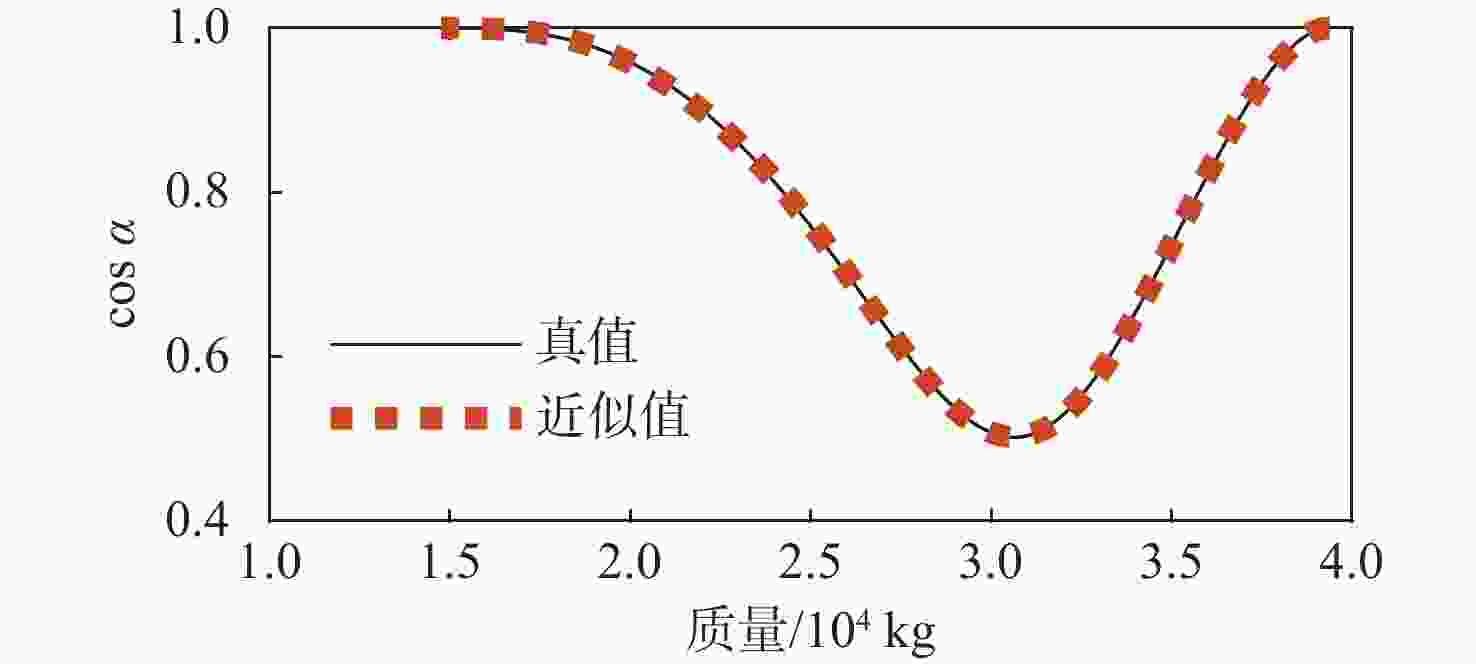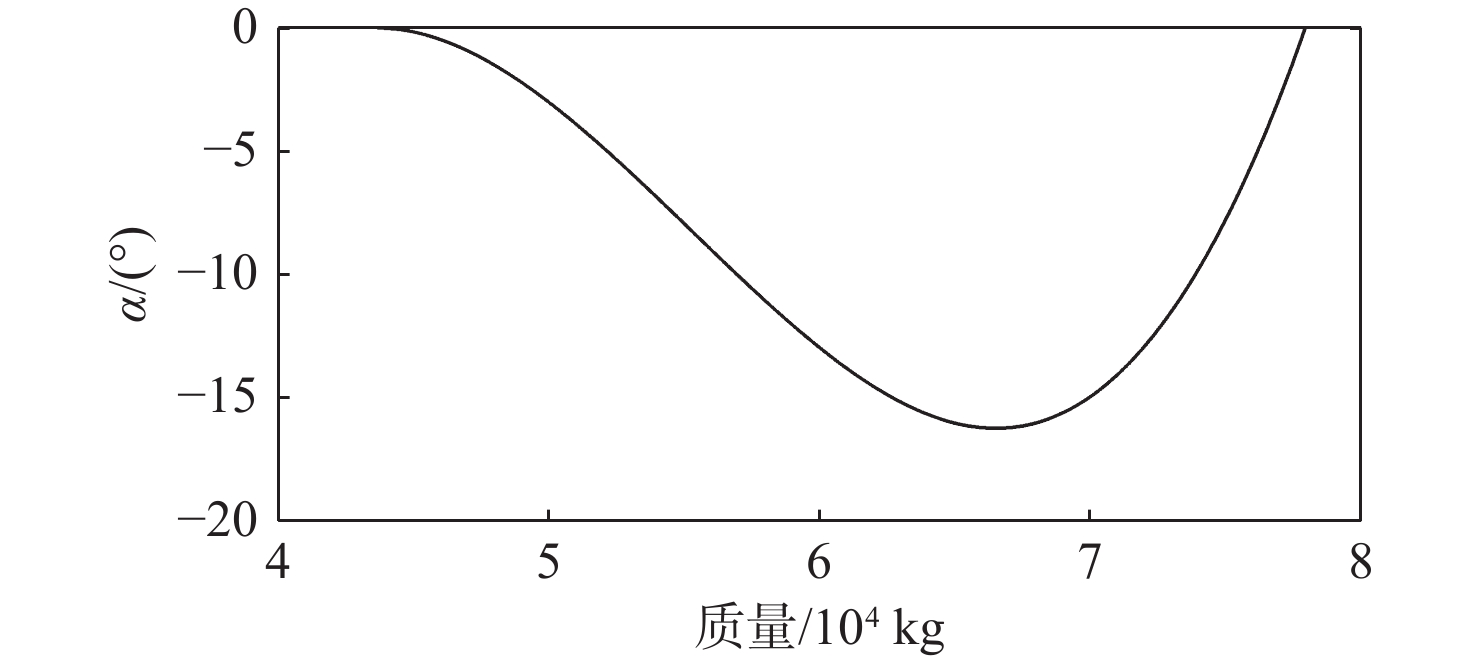-
摘要:
针对运载火箭助推段预测校正制导方法中在线快速轨迹预测困难的问题,提出一种适用于大攻角剖面的运载火箭助推段高精度弹道解析解。推导得到以质量为自变量的纵平面简化动力学模型,并创新性地将攻角的正弦值设计为关于质量的多项式。因为大攻角机动的影响,简化动力学模型依旧是高度非线性的,无法直接求得解析解。通过受力分析,构造近似多项式替代原方程中非线性强但模值较小的项,并将真实值与近似值之差作为摄动小量。根据摄动理论可以对动力学模型进行分阶以获得可以解析求解的子系统。对子系统积分可以得到速度、弹道倾角、航程和高度的解析解。仿真实验表明:在大攻角条件下,所提出解析解的精度比现有解析解至少提升了85%。
Abstract:To rapidly predict the ascent trajectory of launch vehicles, high-accuracy analytical solutions for ascent trajectory were proposed under high angle-of-attack (AOA) conditions. First, a simplified longitudinal-plane dynamics model with mass as the independent variable was developed. The sine of AOA was innovatively expressed as a polynomial of mass. Due to the high AOA, the simplified dynamics model remains highly nonlinear, which prevents it from being analytically solved directly. Approximate polynomials are introduced to replace the strongly nonlinear but relatively small terms in the original equations through force analysis. Furthermore, the difference between the true values and the approximations was treated as a minor perturbation. The dynamics model was divided into analytically solvable subsystems according to the perturbation theory. Analytical solutions for velocity, flight-path angle, downrange, and altitude were derived by solving the subsystems. Simulation results confirm that the proposed solutions are at least 85% more accurate than existing solutions under high AOA conditions.
-
Key words:
- analytical solution /
- ascent trajectory /
- high angle of attack /
- launch vehicle /
- perturbation method
-
表 1 算例一解析解终端误差及计算时间
Table 1. Terminal results and computing time for case 1
速度/(m·s−1) 速度相对误差1/% 速度相对误差2/% 弹道倾角/(°) 弹道倾角
相对误差1/%弹道倾角
相对误差2/%数值仿真 ${x^{\left( 0 \right)}}$ ${x^{\left( 0 \right)}} + {x^{\left( 1 \right)}}$ 数值仿真 ${x^{\left( 0 \right)}}$ ${x^{\left( 0 \right)}} + {x^{\left( 1 \right)}}$ 1 609.5 1 607.6 1 607.9 −0.120 2 −0.098 9 41.728 4 43.475 6 41.435 4 4.187 0 −0.702 3 航程/km 航程相对
误差1/%航程相对
误差2/%高度/km 高度倾
角相对
误差1/%高度倾
角相对
误差2/%计算时间/s 数值仿真 ${x^{\left( 0 \right)}}$ ${x^{\left( 0 \right)}} + {x^{\left( 1 \right)}}$ 数值仿真 ${x^{\left( 0 \right)}}$ ${x^{\left( 0 \right)}} + {x^{\left( 1 \right)}}$ 数值仿真 ${x^{\left( 0 \right)}}$ ${x^{\left( 0 \right)}} + {x^{\left( 1 \right)}}$ 24.507 8 24.995 0 24.819 7 1.988 0 1.272 8 37.833 5 39.671 7 37.869 5 4.858 6 0.095 0 0.819 4 1.563 4×10−5 3.472 0×10−5 注:相对误差1是x(0)相对数值仿真的误差;相对误差2是x(0)+x(1)相对数值仿真的误差。 -
[1] 马树微, 李静琳, 陈曦, 等. 多级固体运载火箭分级多学科设计优化[J]. 北京麻豆精品秘 国产传媒学报, 2016, 42(3): 542-550.MA S W, LI J L, CHEN X, et al. Stage-wise multidisciplinary design optimization for multi-stage solid launch vehicle[J]. Journal of Beijing University of Aeronautics and Astronautics, 2016, 42(3): 542-550 (in Chinese). [2] 程晓明, 尚腾, 徐帆, 等. 基于序列凸规划的运载火箭轨迹在线规划方法[J]. 宇航学报, 2021, 42(2): 202-210. doi: 10.3873/j.issn.1000-1328.2021.02.008HENG X M, SHANG T, XU F, et al. Online trajectory planning for launch vehicles with successive convex programming[J]. Journal of Astronautics, 2021, 42(2): 202-210 (in Chinese). doi: 10.3873/j.issn.1000-1328.2021.02.008 [3] CHENG X M, LI H F, ZHANG R. Efficient ascent trajectory optimization using convex models based on the Newton-Kantorovich/pseudospectral approach[J]. Aerospace Science and Technology, 2017, 66: 140-151. doi: 10.1016/j.ast.2017.02.023 [4] SUN Z X, CHAO T, WANG S Y, et al. Convex method for ascent trajectory optimization using iterative narrowing trust region[C]//Proceedings of the 2018 IEEE CSAA Guidance, Navigation and Control Conference. Piscataway: IEEE Press, 2018: 1-6. [5] PRABHAKAR N, KUMAR I, TATA SK, et al. A predictive explicit guidance scheme for ballistic missiles[J]. Defence Science Journal, 2013, 63(5): 456-461. doi: 10.14429/dsj.63.2575 [6] CAO R, LIU Y B, LU Y P. Robust multiple model predictive control for ascent trajectory tracking of aerospace vehicles[J]. IEEE Transactions on Aerospace and Electronic Systems, 2022, 58(2): 1333-1351. doi: 10.1109/TAES.2021.3117058 [7] 李惠峰, 谢陵. 基于预测校正方法的RLV再入制导律设计[J]. 北京麻豆精品秘 国产传媒学报, 2009, 35(11): 1344-1348.LI H F, XIE L. Reentry guidance law design for RLV based on predictor-corrector method[J]. Journal of Beijing University of Aeronautics and Astronautics, 2009, 35(11): 1344-1348 (in Chinese). [8] YU W B, CHEN W C, JIANG Z G, et al. Omnidirectional autonomous entry guidance based on 3-D analytical glide formulas[J]. ISA Transactions, 2016, 65: 487-503. doi: 10.1016/j.isatra.2016.09.002 [9] YU W B, CHEN W C, JIANG Z G, et al. Analytical entry guidance for no-fly-zone avoidance[J]. Aerospace Science and Technology, 2018, 72: 426-442. doi: 10.1016/j.ast.2017.11.029 [10] SPRENGER A R, JAHANSHAHI S, IVLEV A V, et al. Time-dependent inertia of self-propelled particles: the Langevin rocket[J]. Physical Review E, 2021, 103(4): 042601. doi: 10.1103/PhysRevE.103.042601 [11] 胡锦川. 高超声速飞行器平稳滑翔弹道特性及全程弹道规划与制导方法研究[D]. 北京: 北京麻豆精品秘 国产传媒, 2015.HU J C. Research on steady-glide trajectory characteristics and algorithm design of trajectory planning and explicit guidance for hypersonic vehicle[D]. Beijing: Beihang University, 2015(in Chinese). [12] ZHAO S L, CHEN W C, YANG L. Endoatmospheric ascent optimal guidance with analytical nonlinear trajectory prediction[J]. International Journal of Aerospace Engineering, 2022, 2022(1): 5729335. [13] ZHANG Q, XU Z. Autonomous ascent guidance with multiple terminal constraints for all-solid launch vehicles[J]. Aerospace Science and Technology, 2020, 97: 105633. doi: 10.1016/j.ast.2019.105633 [14] YU Q, CHEN W C, YU W B. Approximate analytical solutions for launch-vehicle ascent trajectory[J]. IEEE Transactions on Aerospace and Electronic Systems, 2023, 59(4): 4033-4048. doi: 10.1109/TAES.2023.3235867 [15] VEPA R. Flight dynamics, simulation, and control: for rigid and flexible aircraft[M]. 2nd ed. Boca Raton: CRC Press, 2023. [16] YU W B, CHEN W C, JIANG Z G, et al. Analytical entry guidance based on pseudo-aerodynamic profiles[J]. Aerospace Science and Technology, 2017, 66: 315-331. doi: 10.1016/j.ast.2017.03.018 [17] 孙勇强, 佟明羲, 王鹏飞, 等. 国外固体运载火箭主动力系统发展研究[J]. 宇航总体技术, 2022, 6(4): 56-64.SUN Y Q, TONG M X, WANG P F, et al. Research on the development of the main propulsion system of foreign solid launch vehicles[J]. Astronautical Systems Engineering Technology, 2022, 6(4): 56-64(in Chinese). [18] 陈克俊, 刘鲁华, 孟云鹤. 远程火箭飞行动力学与制导[M]. 北京: 国防工业出版社, 2014.CHEN K J, LIU L H, MENG Y H. Launch vehicle flight dynamics and guidance[M]. Beijing: National Defense Industry Press, 2014(in Chinese). [19] NORTHROP GRUMMAN INNOVATION SYSTEMS. Minotaur IV•V•VI User's Guide[EB/OL]. (2023-07-30)[2013-06-09]. http://www.manualsdir.com/manuals/569830/orbital-minotaur-ri-mibotaur-v-minotaur-iv.html. [20] 陈赟. 运载火箭助推段轨迹优化与制导方法研究[D]. 武汉: 华中科技大学, 2019.CHEN B. Research on trajectory optimization and guidance method for the booster of launching vehicle[D]. Wuhan: HuaZhong University of Science and Technology, 2019(in Chinese). -







 下载:
下载:









